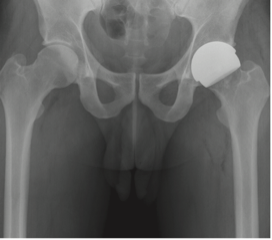Hip Resurfacing has started to regain popularity as a result of newer materials that have recently been approved. In the past only young male patients (<60) were suitable for this type of replacement, however with newer non metal-on-metal resurfacing implants, young active females are now eligible for resurfacing replacements.
The advantage for the young adult is that it may allow the patient to do more robust type sports like regular jogging, touch football, social soccer and generally higher impact sports. It is still a replacement and patients need to be aware that it cannot behave and feel like a normal joint and rarely it may still result in complications due to metal on metal surfaces such as metal allergy, fluid build-up and in rare cases soft tissue damage. The new ceramic-on-ceramic resurfacing eliminates the concerns of metal ion issues.
The Birmingham hip resurfacing, BHR, is the gold standard of hip resurfacing implants. It is a metal on metal resurfacing. Recently the BHR manufacturer (Smith & Nephew) has stopped manufacturing however the Adept metal-on-metal resurfacing which is identical to the BHR, is still manufactured by a company called MattOrtho and has exactly the same results as the BHR.
Ceramic Hip Resurfacing
Hip resurfacing has been a very successful way of treating young active males with advanced hip osteoarthritis. The Birmingham Hip Resurfacing has a 25-year clinical follow up in the UK and 23 years in Australia. According to the Australian National Joint Registry, Males have a 7.9% revision rate at 23 yrs in Australia.
Hip Resurfacing allows higher impact sport activities and Andy Murray is one of the most well-known sportsmen who has had a metal-on-metal hip resurfacing.
The advantage of a resurfacing in appropriately selected patients compared to standard hip replacements is that a resurfacing replacement preserves femoral bone stock, allows repetitive high impact activities / contact sports and has a low risk of dislocation.
Metal on Metal Resurfacings have done poorly in women for a number of reasons including smaller bones not allowing adequate implant sizing creating issues with metal-on-metal wear particles.
Over the last 6.5 years a carefully controlled multicentre worldwide trial has been testing a ceramic-on-ceramic resurfacing implant. There is no metal involved in the bearing and the thought is that the metal-on-metal wear problems will therefore no longer exist. This will also allow women to have the ability to have a hip resurfacing.
The Recerf ceramic hip resurfacing (manufactured by MattOrtho https://www.matortho.com/recerf) has recently been approved in Australia and whilst it has been implanted in a trial over the past 6 years, the latest published data has an average 4 year follow up in 600 hips. The follow up data is showing excellent outcomes with 98% survival at 5 years.
So far, the results look very promising but long-term results (over 10 years) are needed to make a true comparison to metal resurfacings and conventional hip replacement.
My approach to ceramic hip resurfacing is to provide a patient with the latest data and allow patients to make an informed decision as to what they would like. The surgery is basically identical to a metal-on-metal resurfacing with the same posterior approach incision, same soft tissue releases and same post operative protocol.
Impact sports are not recommended for a minimum of 8 months after surgery.

Resurfacing Replacement vs Conventional Hip Replacement
Pre Op Resurfacing information
Get Adobe ReaderYou will need the Adobe Reader to view & print these documents.





